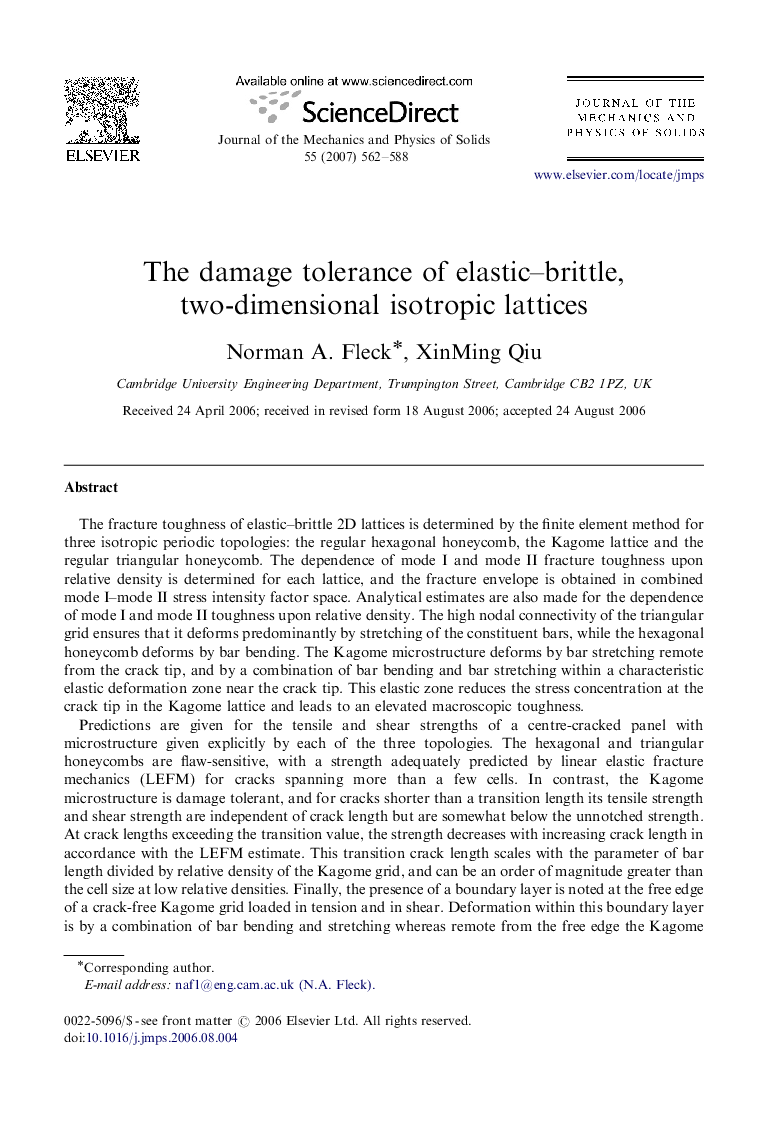| کد مقاله | کد نشریه | سال انتشار | مقاله انگلیسی | نسخه تمام متن |
|---|---|---|---|---|
| 797536 | 1467163 | 2007 | 27 صفحه PDF | دانلود رایگان |

The fracture toughness of elastic–brittle 2D lattices is determined by the finite element method for three isotropic periodic topologies: the regular hexagonal honeycomb, the Kagome lattice and the regular triangular honeycomb. The dependence of mode I and mode II fracture toughness upon relative density is determined for each lattice, and the fracture envelope is obtained in combined mode I–mode II stress intensity factor space. Analytical estimates are also made for the dependence of mode I and mode II toughness upon relative density. The high nodal connectivity of the triangular grid ensures that it deforms predominantly by stretching of the constituent bars, while the hexagonal honeycomb deforms by bar bending. The Kagome microstructure deforms by bar stretching remote from the crack tip, and by a combination of bar bending and bar stretching within a characteristic elastic deformation zone near the crack tip. This elastic zone reduces the stress concentration at the crack tip in the Kagome lattice and leads to an elevated macroscopic toughness.Predictions are given for the tensile and shear strengths of a centre-cracked panel with microstructure given explicitly by each of the three topologies. The hexagonal and triangular honeycombs are flaw-sensitive, with a strength adequately predicted by linear elastic fracture mechanics (LEFM) for cracks spanning more than a few cells. In contrast, the Kagome microstructure is damage tolerant, and for cracks shorter than a transition length its tensile strength and shear strength are independent of crack length but are somewhat below the unnotched strength. At crack lengths exceeding the transition value, the strength decreases with increasing crack length in accordance with the LEFM estimate. This transition crack length scales with the parameter of bar length divided by relative density of the Kagome grid, and can be an order of magnitude greater than the cell size at low relative densities. Finally, the presence of a boundary layer is noted at the free edge of a crack-free Kagome grid loaded in tension and in shear. Deformation within this boundary layer is by a combination of bar bending and stretching whereas remote from the free edge the Kagome grid deforms by bar stretching (with a negligible contribution from bar bending). The edge boundary layer degrades both the macroscopic stiffness and strength of the Kagome plate. No such boundary layer is evident for the hexagonal and triangular honeycombs.
Journal: Journal of the Mechanics and Physics of Solids - Volume 55, Issue 3, March 2007, Pages 562–588